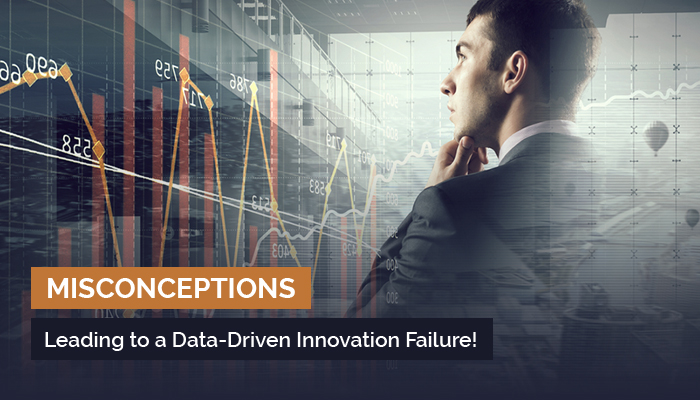
1000+
customers

50+ countries
across the world

Outsourcing leader
since 2008

Technology-driven
services

Stringent
quality processes
Misconceptions That Lead to a Data-Driven Innovation Failure!
Last updated: 16 Apr, 2024 By Bibin Dominic | 6 Minutes Read

Almost 90% of consumer-oriented innovations fail to survive in the market, while B2B products and services have a comparatively lower percentage. You might remember Blackberry phones that came up with an innovative concept of having a full qwerty keypad in a smartphone. No doubt, the phones had created hype in the market, but later with the trend of full touch screen phones, Blackberry phones got obsolete.
Well, with regards to data-driven innovation failure, the reasons can vary from a bad product launch strategy to being unable to develop products or services (post-launch) to meet market requirements.
For example, Yahoo!, throughout the 1990s, was leading the market due to its directory-based search system, as later the World Wide Web grew rapidly, this system experienced several limitations. Further, with the advent of Google’s PageRank algorithm, Yahoo! experienced a massive decline in the rate of monthly users. As a result, it was sold out in 2016 to Verizon for $5 billion, which, in 1999, had a worth of $120 billion.
Data capture and exploitation have acted as the appropriate resources for most tech giants over the past few years. Since the amount of data that is generated by activities on the internet continues to expand, thousands of companies and even startups are developing new products and services by exploiting this precious resource. Most of such innovations would not succeed due to any apparent reason, such as improper data management, incomplete or false data, data breach, etc.
However, having a clear understanding of these five reasons behind such failures will help in reducing the risks, especially if you have decided to walk on this challenging yet highly profitable road to success.
5 Reasons Why A Data-Driven Innovation Fails
1. Products That Don’t Fit With Market Needs
While this is important to ensure before launching some service or product, many companies still develop and launch online services without considering if they are solving a problem or addressing an actual requirement for something. Google can be an appropriate example here. The company introduced its social networking platform in 2011 named – Google Plus, which later discontinued in October 2018. It merely represents that having abundant data is not enough to launch a product on the market.
Though Google was having complete access to the online activities of users in billions and had invested billions of dollars in developing the service portal, it never gained enough userbase in the social media industry. Google was under a big misconception that Google Plus would become a fierce competition for existing services. But, it failed as there was no solid reason for users to switch from aggressively trending social sites such as Twitter, Facebook, and Instagram.
2. Blind Faith In Third-Party Data Providers
As data can be easily captured, stored, copied, and shared, it becomes a potent commodity to build services from. At the same time, this also produces weaknesses for companies. Public bodies across the globe are readily providing their data sets for commercial re-use. For example, Data.gov in the U.S. is a platform to find unique, large-scale, and free data.
There are many companies building businesses by utilizing such databases. But the actual problem is that anyone else can do the business of data using third-party data services. In such a case, the trick is to obtain third-party data management services to improve the value of the captured data and maintain stronger customer relationships; to protect your business from the competition or make it very difficult for the competitors to take your customers away.
3. Centric Focus On Building A Product, Not A Community
It is highly essential to create an environment for your product or service and its users. This becomes possible by involving collaborations with third parties and gathering data from customers to build a resource that brings value and keeps the competitors’ offering out of the competition.
For instance, Steve Jobs initially refused to work on the idea of an app store that was projected to be open to third party mobile application developers. But today, iPhone’s success is based on more than a million downloadable applications on the app store.
In the world of IoT data, Terbine is offering companies around the globe to sell data. If this global exchange of data gets to larger scales, it could bring value from millions of data streams and trigger innovations.
4. Misinterpreting Data As A Physical Asset
Data can not be included among corporate assets, such as office infrastructure. Still, many CEOs and managers are unaware of the economic features of data and how it is sold in the market. Depending upon how it was produced and collected, data will have varying fixed costs, however, almost zero costs for replication and distribution.
One of the characteristics of data that doesn’t allow it to be counted as a physical asset is that once you sell it out, it can still generate value. Facebook & Google have reached to the top utilizing this characteristic to the core. They analyze which search results are getting more clicks and the type of stories users read in the newsfeed. As a result, they are able to provide better services and offer more relevant results to consumers and more target-specific campaigns for advertisers.
Make proper use of such data filled with feedbacks to recognize which products and services require improvement and identify possible revenue streams.
5. Being Unable To Find A Niche
First things first, you need to find a niche you can cater to for long and create a solution within that very niche that provides a service that is yet to be introduced in the market or is way better than the existing alternatives. Finding a niche is vital to come up with an impactful innovation. Even after this, keep in mind not to fall into distress due to obvious threats to failure and try to stay one step ahead of the potential issues that may arise.
But, then, how should you find your niche?
It would be a big challenge for you as it requires thorough introspection and a willingness to pick out and admit your weaknesses. Here, SWOT analysis can help find your strengths and weaknesses. Once you discover your strengths to become an innovator, you can go further with overcoming your weaknesses while refining the skills you already have mastered.
After learning the reasons behind the failure, let’s now discuss the future of data-driven innovations in brief.
What Could Be The Future of Data-Driven Innovations?
The Data-Driven Economy
The data-driven economy is likely to generate a massive amount of economic value. As per the estimation of McKinsey & Company (a management consulting firm), “better use of data could increase world income by $3 trillion each year in seven industries alone.” The economic value of data increases when you share it. Similar to other resources, data is capable of creating value only if it is used to improve products and services that actually satisfy customer needs.
The Agenda Of Competition
A dynamic and energetic STEM workforce is essential for the competitiveness in the data-driven economy. Without access to high-performance broadband, it would be next to impossible to realize the real potentials of the economy driven by data. There’s a need to realign R&D to increase data-driven innovation capabilities along with private-public participation in data sharing. Trade practices and agreements must ensure the processing, utilization, and complete protection of data.
Good Public Data Policies
Implementation of good policies for corporate and public data would serve the common good. Big Data requires to be based on open standards and needs advanced solutions to enforce and monitor high quality in acquisition and utilization.
Public policies need to encourage responsible and authorized data utilization. Address data security and privacy concerns adequately that are innovative, flexible, and technologically appropriate. Policies that restrict the access and sharing of data are crucial impediments to innovation.
Driving Innovation Using Open Data
Open Data is also a significant source of information that delivers innovative solutions. Unlike Big Data, which mostly remains private, you can access Open Data as it is a free resource. Any business can build a new business, gain intelligence in business, and enhance business processes. While Open Data comes from multiple sources, such as private companies, social media, and scientific research, most-used Open Data actually comes from government offices and agencies.
Governments require improving processes and policies to release accessible, relevant, and useful Open Data sources to boost innovation, keep public informed, and increase economic opportunities.
Going back in the past, multiple industries have experienced slow growth toward such data-oriented goals; however, the situation appears to be even worse today.
NewVantage Partners’ Big Data and AI Executive Survey has provided alarming results. The survey included 64 c-level business and technology executives as participants, representing some of the largest corporations, such as Ford Motor, General Motors, American Express, General Electic, and Johnson & Johnson.
Here are the key findings from the survey:
72% of survey participants report that they have yet to forge a data culture.
69% report that they have not created a data-driven organization.
53% state that they are not yet treating data as a business asset.
52% admit that they are not competing on data and analytics.
Conclusion
When it comes to generating innovative ideas, you may consider relying on reliable external data. You may also produce and improve high-quality data to prevent your innovations from failure. An important thing to note here is that quality should be your top priority to make your data-driven business plan succeed in this modern era.
As markets and economies are adapting to the emerging world of data-driven businesses, traditional ways of product development should also be in the consideration for successful collaborative innovations. This especially goes for firms that add data capture and functionality analysis to physical product lines. With innovative data-driven services come new ways of engagement.
Recommended – Guidelines to Monitor Data Quality Management with the Right Metrics
Since data is the base of several innovations, you will still require proper data management. If you are facing issues in processing informative data or keeping it secure, it’s time to outsource data management to Cogneesol – a leading business process outsourcing company, having more than 16 years of experience in delivering excellent services across the world.
For more information, call us today at +1 646-688-2821 or email at [email protected].
Latest Blogs

This site is protected by reCAPTCHA. Google's Privacy Policy
and Terms of Service apply.










